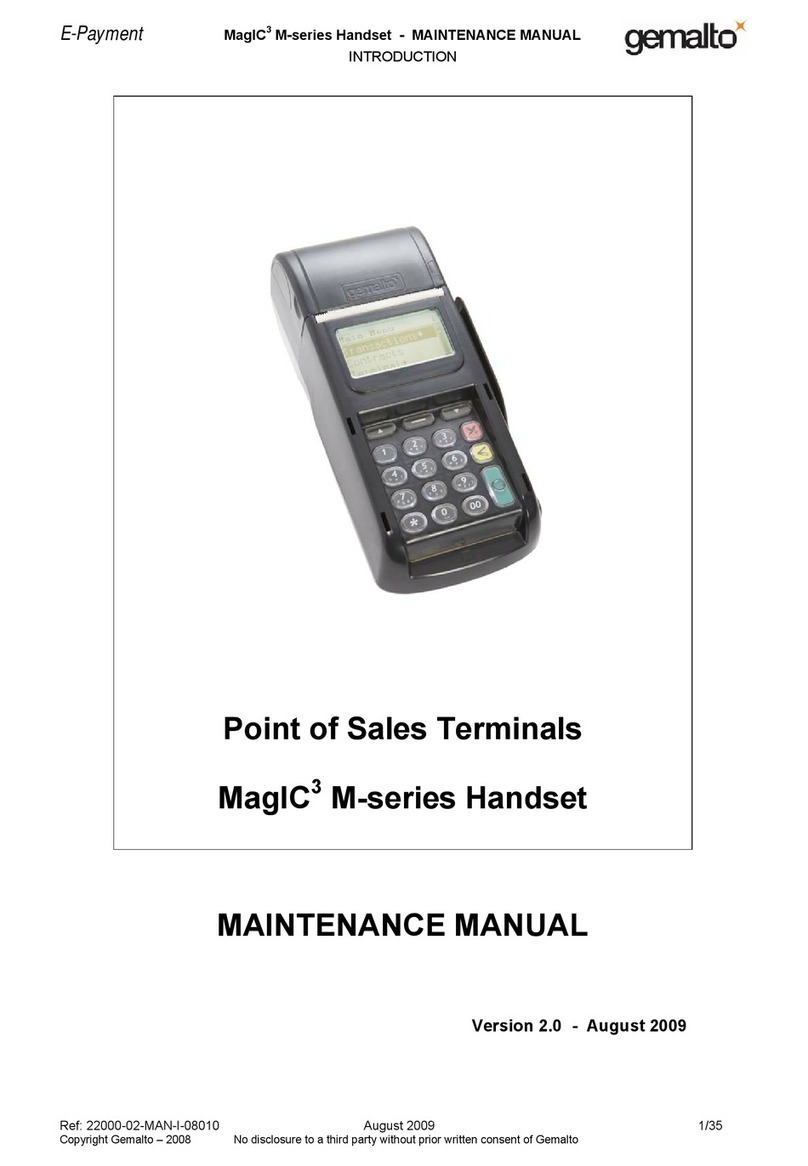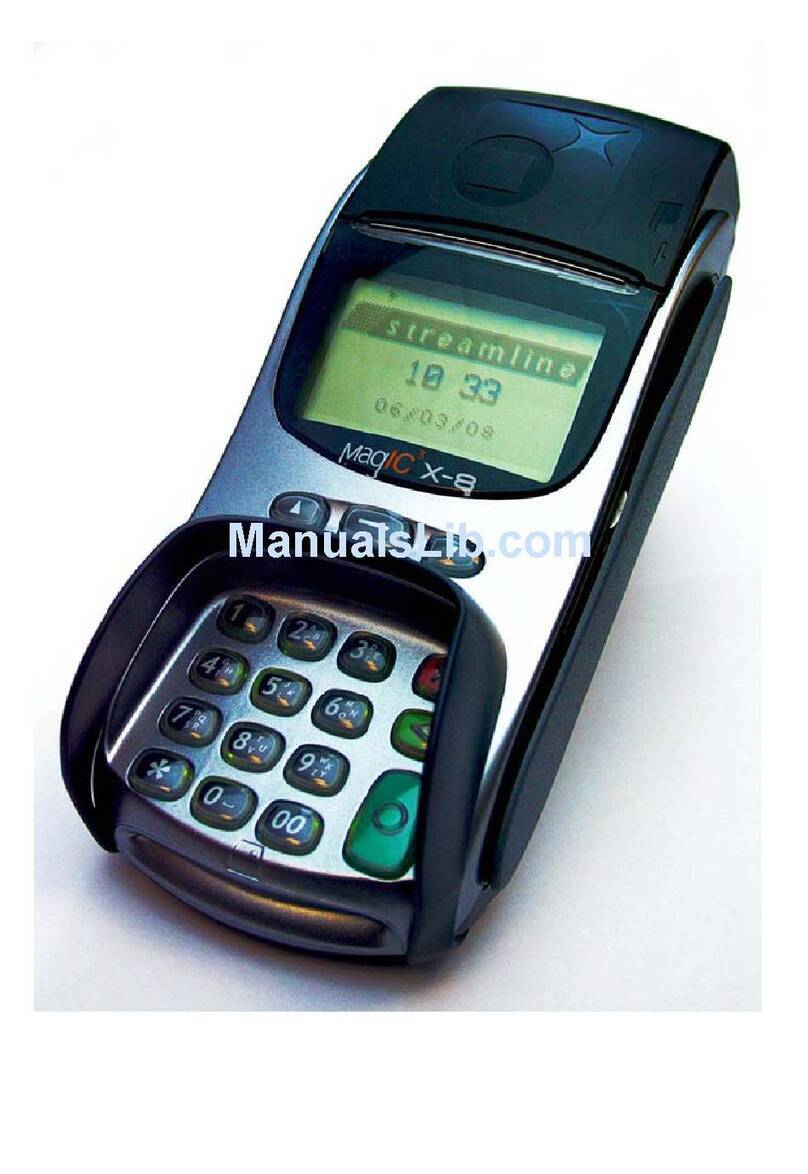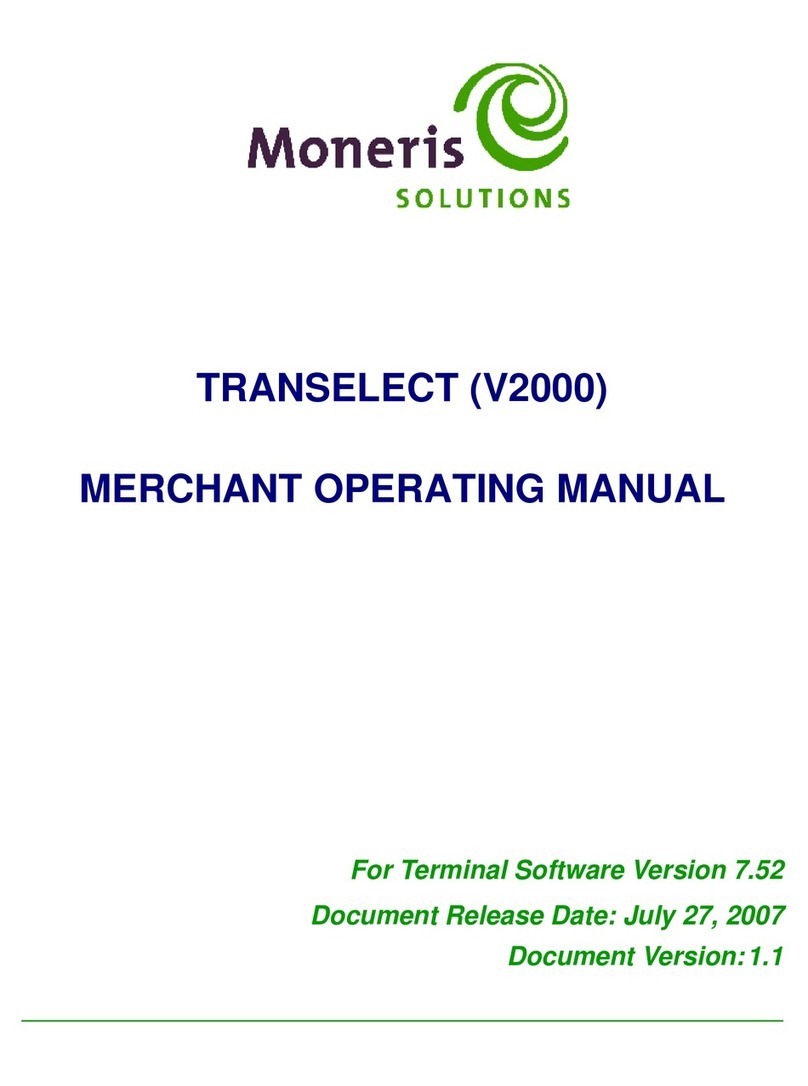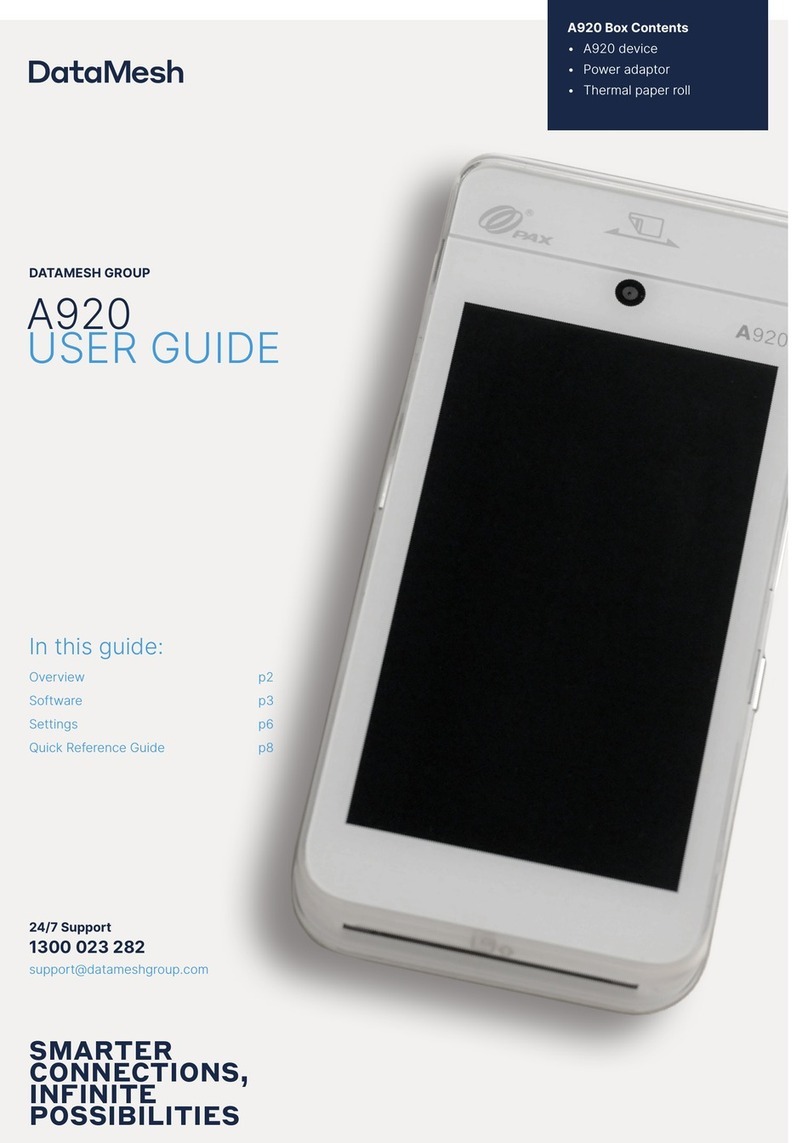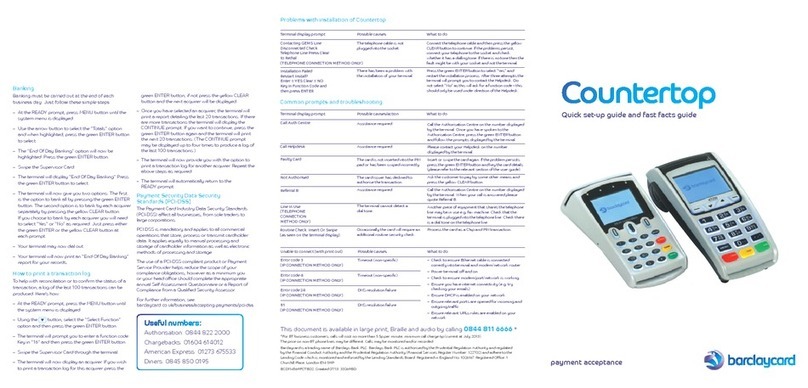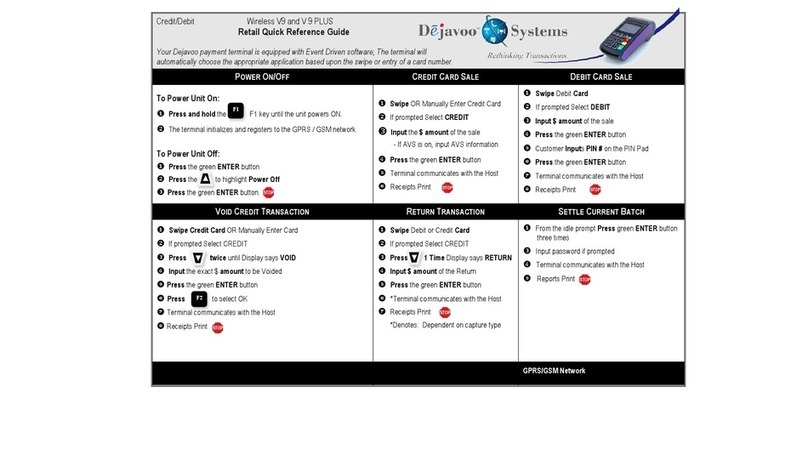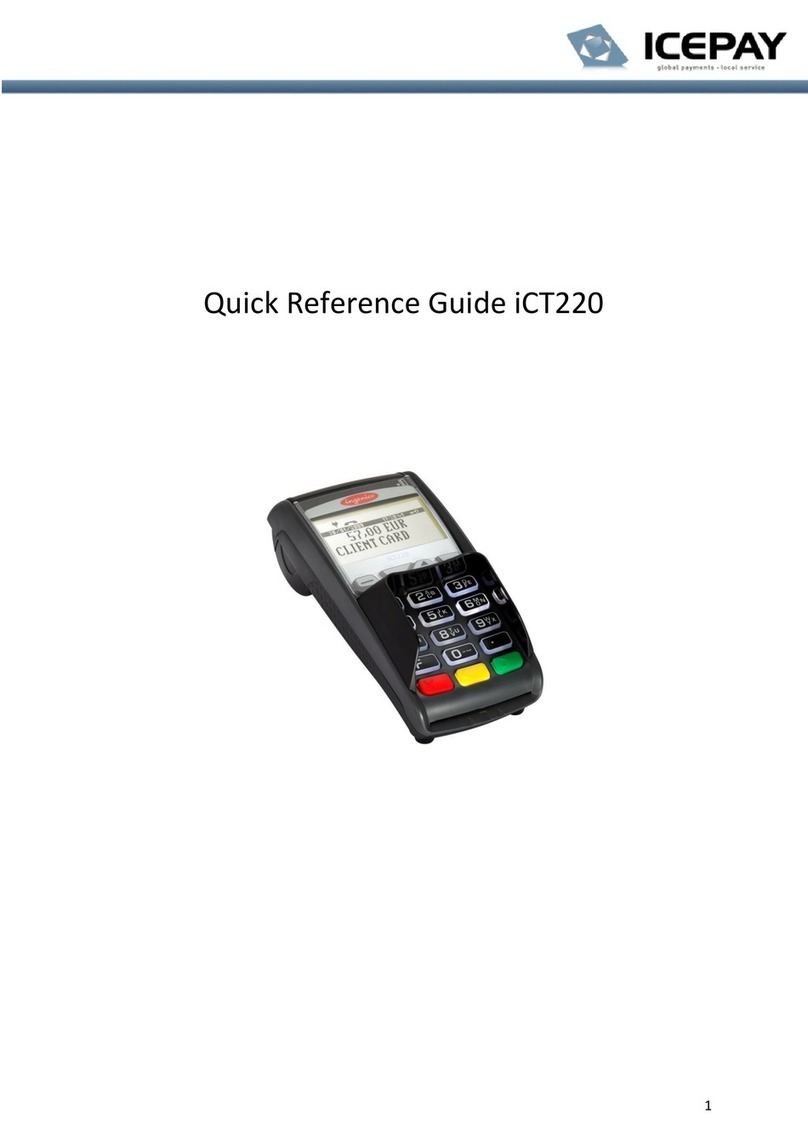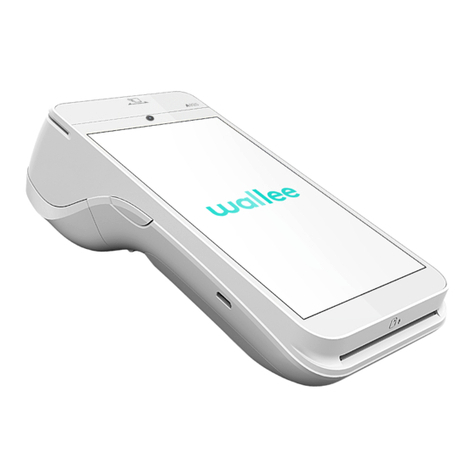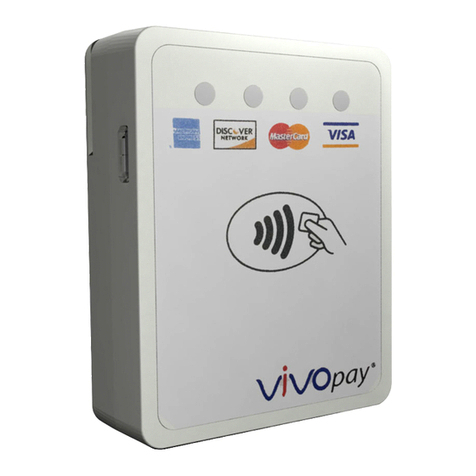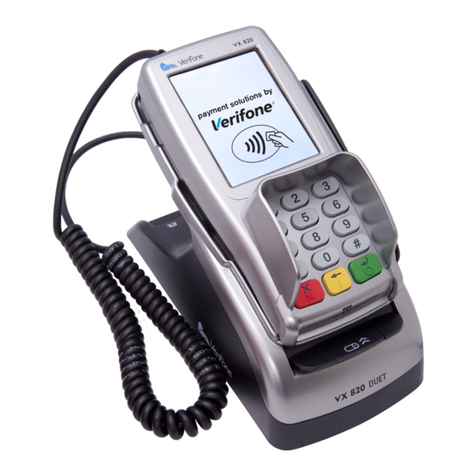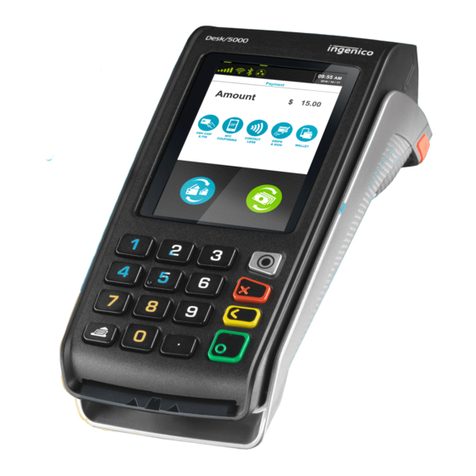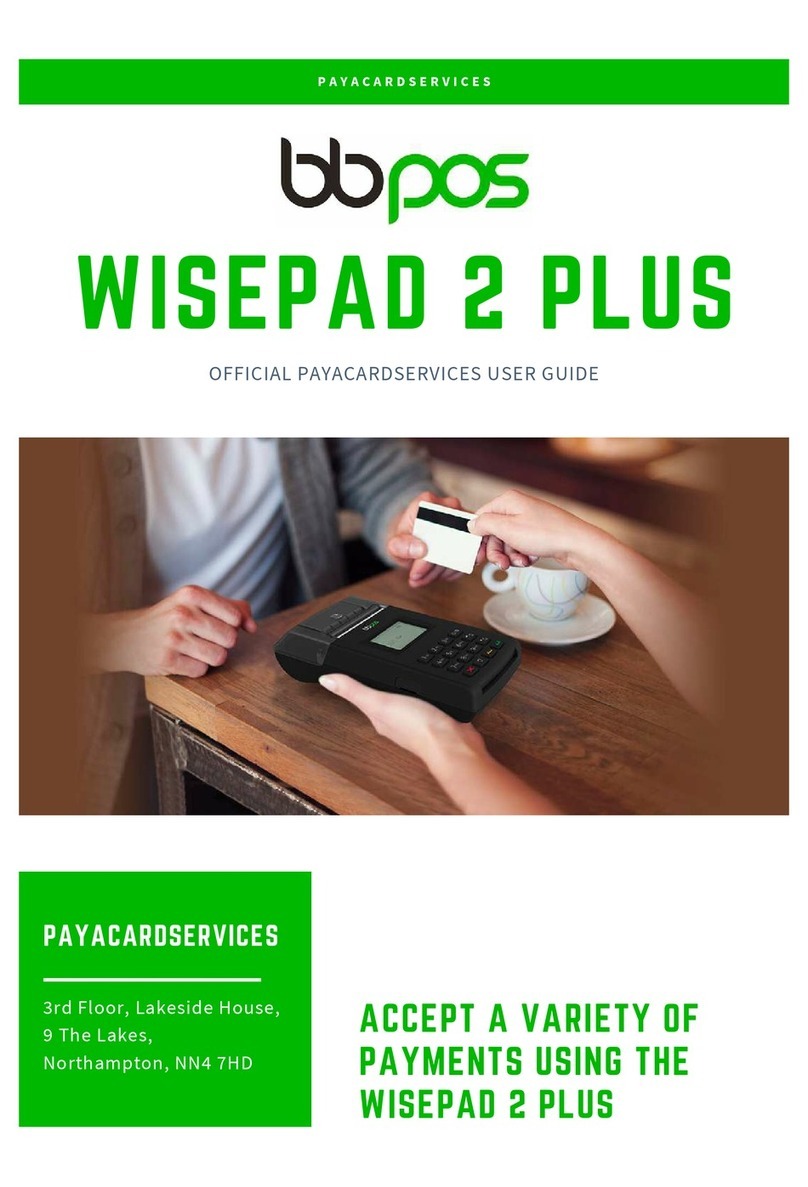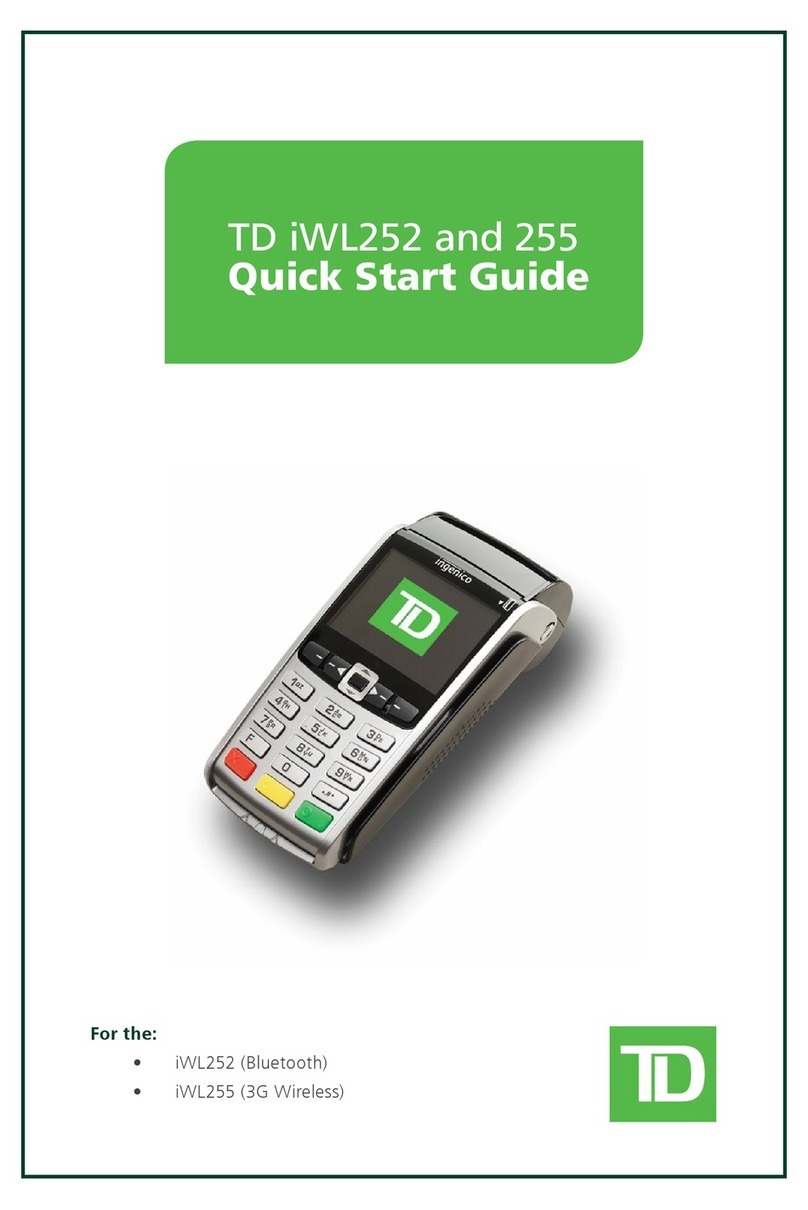Gemalto MagIC3 C-series User manual

E-Payment MagIC3C-series - MAINTENANCE MANUAL
INTRODUCTION
Ref: 22000-01-MAN-I-09010 Sept 2009 1/32
Copyright Gemalto – 2009 No disclosure to a third party without prior written consent of Gemalto
Point of Sales Terminals
MagIC3C-series
MAINTENANCE MANUAL
Version 2.0 - Sept 2009

E-Payment MagIC3C-series - MAINTENANCE MANUAL
INTRODUCTION
Ref: 22000-01-MAN-I-09010 Sept 2009 2/32
Copyright Gemalto – 2009 No disclosure to a third party without prior written consent of Gemalto
COPYRIGHT AND PROPRIETARY LEGENDS
These materials contain confidential and proprietary information in the nature of, for
example, trade secrets and know-how, and are not to be distributed or divulged to third
parties, or duplicated in whole or in part without prior written permission from Gemalto E-
Payment, and are subject to use, copying, and disclosure restrictions contained in a
agreement with Gemalto E-Payment.
These materials are to be used only for the intended purpose agreed upon in the related
contract with Gemalto E-Payment. IN NO EVENT SHALL GEMALTO E-PAYMENT BE
LIABLE FOR SPECIAL, INDIRECT, OR CONSEQUENTIAL DAMAGES IN CONNECTION
WITH OR ARISING FROM THE USE OF THIS DOCUMENT OR ANY PROGRAMS
CONTAINED HEREIN. GEMALTO E-PAYMENT EXPRESSLY DISCLAIMS ANY
WARRANTY OF MERCHANTABILITY OR FITNESS FOR A PARTICULAR PURPOSE IN
RELATION TO THIS DOCUMENT OR ANY PROGRAMS CONTAINED HEREIN.
Copyright (c) 2009 by Gemalto
All rights reserved.

E-Payment MagIC3C-series - MAINTENANCE MANUAL
INTRODUCTION
Ref: 22000-01-MAN-I-09010 Sept 2009 3/32
Copyright Gemalto – 2009 No disclosure to a third party without prior written consent of Gemalto
MODIFICATION SHEET
Date Version Modifications
July 2009 1.0 Initial
Sept 2009 2.0 Release after review

E-Payment MagIC3C-series - MAINTENANCE MANUAL
INTRODUCTION
Ref: 22000-01-MAN-I-09010 Sept 2009 4/32
Copyright Gemalto – 2009 No disclosure to a third party without prior written consent of Gemalto
Table of contents
INTRODUCTION...................................................................................................................5
1. Scope.............................................................................................................................5
1.1 References..............................................................................................................5
1.2 MagIC3Diag software.............................................................................................5
1.3 Abbreviations used .................................................................................................5
I) - DESCRIPTION ................................................................................................................6
1. System Product Architecture design..............................................................................6
1.1 Technical overview .................................................................................................6
1.2 Physical Architecture ..............................................................................................8
2. Software Architecture...................................................................................................14
II) - TROUBLESHOOTING..................................................................................................16
1. Introduction ..................................................................................................................16
1.1 Methodology .........................................................................................................16
1.2 Safety regulation...................................................................................................16
1.3 Special tools and test equipment..........................................................................16
1.4 Procedure .............................................................................................................17
2. Troubleshooting Instructions........................................................................................18
2.1 POWER SUPPLY failure.......................................................................................18
2.2 DISPLAY failure....................................................................................................19
2.3 KEYBOARD failure...............................................................................................20
2.4 PRINTER failure ...................................................................................................21
2.5 MAGNETIC READER failure ................................................................................22
2.6 CUSTOMER SMART CARD READER failure......................................................23
2.7 SAM READER (SIM-sized) failure........................................................................24
2.8 I/O (USB, Modem) failure......................................................................................24
2.9 SECURITY ALERT / LITHIUM BATTERY failure..................................................25
3. SECURITY ALERT – How to interprete SP Status information....................................28
3.1 SP STATUS ticket information..............................................................................29
3.2 UKSR/SECIRQ values meanings .........................................................................30
3.3 Interpreting UKSR/SECIRQ values.......................................................................30
III) - MAINTENANCE …………………………………………………………..……………. RI[01]

E-Payment MagIC3C-series - MAINTENANCE MANUAL
INTRODUCTION
Ref: 22000-01-MAN-I-09010 Sept 2009 5/32
Copyright Gemalto – 2009 No disclosure to a third party without prior written consent of Gemalto
INTRODUCTION
1. Scope
This document relates to the MagIC3C-series Terminal. The aim of this manual is to give
necessary technical information and procedures to carry out all maintenance activities
needed during the life span of the MagIC3C-series Terminal.
This guide is divided in 3 parts:
•I) Description, consisting in a detailed description of the terminal and its equipment.
•II) Troubleshooting, explaining how to find the root cause of failures.
•III) Maintenance, containing replacement procedures for all parts that can be
exchanged during Maintenance level 2 operation.
It mainly makes reference to the Maintenance software MagIC3-Diag RI[02].
1.1 References
RI[01] : 22000-01-MAN-I-09011 Part III - MAINTENANCE
RI[02] : 15200-00-MAN-S-07001 Maintenance software, MagIC3-Diag User Manual
1.2 MagIC3Diag software
You have to use MagIC3Diag version 1.5 minimum to test C-series. This software tool
is available on the MPO site.
1.3 Abbreviations used
AM Application Manager
MMS MagIC Management System
MP Main Processor
OS Operating System
PCB Printed Circuit Board
POS Point Of Sale
SAM Security Application Module
SIM Subscriber Identification Module
SMD Surface Mounted Device
SP Secure Processor
TMS Terminal Management System

E-Payment MagIC3C-series - MAINTENANCE MANUAL
Chapter 1 : DESCRIPTION
Ref: 22000-01-MAN-I-09010 Sept 2009 Ch.1 - 6/32
Copyright Gemalto – 2009 No disclosure to a third party without prior written consent of Gemalto
I) - DESCRIPTION
1. System Product Architecture design
1.1 Technical overview
The C-series Terminal product is based on dual micro-processor architecture, the secure
microcontroller to manage security purposes, the main processor as application manager.
The Terminal architecture is mainly made of 3 electronic boards:
•The Keyboard PCB supports the keypad rubber membrane, the Smart card reader,
the display connectors and the SP (Secure Processor). This PCB is connected to
the Main board through 20-pin board-to-board connector.
•The Main PCB supports the MP (Main Processor), memories (RAM, Flash,
EEPROM), connectors for devices (SAM reader, mag stripe rdr, printer, USB-A,
Modem & power supply jack). Lithium battery backup is located on this board too.
•A secure box, mades of PCB, that covers sensitive signals/components of the
keyboard board.
The Terminal is made of following devices:
•32-bit RISC core ARM7, as SP (Secure Processor) ;
•32-bit RISC core ARM9, as MP (Main Processor) ;
•4 Mb Flash, 16 Mb SDRAM, 1024-bit EEPROM ;
•Lithium battery to back-up sensitive data and triggering data stored in SP ;
•Magnetic stripe reader ;
•Customer smart card reader ;
•1 accessible SIM-sized reader ;
•128x64 graphic display (no backlight, no icons) ;
•Keypad (no backlight) ;
•Buzzer ;
•Thermal printer ;
•Modem ;
•1 USB host ;
•Power supply input.

E-Payment MagIC3C-series - MAINTENANCE MANUAL
Chapter 1 : DESCRIPTION
Ref: 22000-01-MAN-I-09010 Sept 2009 Ch.1 - 7/32
Copyright Gemalto – 2009 No disclosure to a third party without prior written consent of Gemalto
1. Printer 6. SIM-sized reader for
application purpose.
2. Display 7. USB Device
3. Keyboard 8. Power Supply
4. Smart Card Reader 9. Modem
5. Magnetic Stripe Reader
2
3
5
1
4
6
7 8 9

E-Payment MagIC3C-series - MAINTENANCE MANUAL
Chapter 1 : DESCRIPTION
Ref: 22000-01-MAN-I-09010 Sept 2009 Ch.1 - 8/32
Copyright Gemalto – 2009 No disclosure to a third party without prior written consent of Gemalto
1.2 Physical Architecture
1.2.1 Block diagram
Main Processor
AT91SAM9260
Thermal
printer
Driver
Secure Processor
AT91SO101
ROM: 32 kbytes
EEPROM: 256 kbytes
RAM: 100 kbytes
h/w TRNG, TDES, RSA accelerator
Intrusion sensors,
Protection against SPA/DPA attacks
Environment protection systems (Voltage, frequency
temperature, UV)
SIM card reader
Customer
smart card reader
Intrusion switches
& mesh sensors
Battery backup
Graphic display
Graphic display
Buzzer
Keyboard
EEPROM
FLASH
EPROM
SDRAM
Magnetic
stripe
d
Driver
Modem Vin USB-h < In/Out
rj11 jack usb-a < connectors
Element located or linked with Keyboard pcb
Element located or linked with Main pcb
Modem DSP / DAA
Power
management

E-Payment MagIC3C-series - MAINTENANCE MANUAL
Chapter 1 : DESCRIPTION
Ref: 22000-01-MAN-I-09010 Sept 2009 Ch.1 - 9/32
Copyright Gemalto – 2009 No disclosure to a third party without prior written consent of Gemalto
1.2.2 The AT91SO101, the Secure Processor
The AT91SO101 is a single package solution in BGA256 embedding two chips, the
AT91SO100 and the AT83C26
The AT91SO100 is a 32-bit microcontroller based on the ARM RISC architecture
(ARM7TDMI code compatible) with embedded EEPROM, RAM and peripheral functions. It
achieves throughputs close to 1 MIPS per Mhz.
The AT83C26 is a multiple Smart Card Reader interface. Combined to the AT91SO100, it
makes a fully compatible solution with ISO7816, EMV2000 level1 standards.
Below are the main features of the AT91SO101:
•256 Kb EEPROM, 96 Kb RAM, 4 Kb crypto RAM, 32 Kb ROM
•RTC, System timers, Communication ports
•1x ISO7816 controller
•1x ISO7816 multiplexed to address up to 4 SAM in our application
•DES3, AES, SHA, crypto multiplier (RSA, DSA, key generation, ECC)
•True random number generator
Security features :
•256 bits for key storage (battery backup)
•Dedicated hardware for protection against SPA/DPA attacks
•Active shield, intrusions sensors (mesh & switches)
•Environmental protection (voltage, frequency, temperature)
•Secure memory management
1.2.3 The AT91SAM9260, as Main Processor
The AT91RM9260 is a complete system-on-chip built around the ARM926EJ-S core.
The AT91RM9260 operating frequency can go up to 200 MHz.
The ARM926EJ-S, an ARM9 32-bits RISC processor with :
•Mode Thumb
•8 Kb Data cache, 8 Kb instruction cache
•MMU to provide access permission checks for instruction and data
•A set of system peripherals & interfaces ; timers, RTC, interrupt controller, I/O, USB,
etc…
•Embedded memories (8 Kb SRAM, 32 Kb ROM)

E-Payment MagIC3C-series - MAINTENANCE MANUAL
Chapter 1 : DESCRIPTION
Ref: 22000-01-MAN-I-09010 Sept 2009 Ch.1 - 10/32
Copyright Gemalto – 2009 No disclosure to a third party without prior written consent of Gemalto
1.2.4 External Memory
1.2.4.1 FLASH
The Flash (4 Mb NOR-Flash) contains boot and compressed executable files as Linux, AM,
Applications, … The executable files are uncompressed and copied in SDRAM for
execution. Flash can be compared to the disk of your PC, a kind of Flash-disk.
1.2.4.2 SDRAM
The SDRAM (16 Mb) is used by MP as executable area (Linux, AM, Applications, …) and
working area (stacks, buffers, variables, …). The SDRAM content is lost when system
powered down.
1.2.4.3 EEPROM
This E2PROM (1024 bits) is used to keep Gemalto and manufacturer information such as
serial number for instance. This component is interfaced to the AT91SAM9260.
1.2.5 Magnetic stripe card reader interface
This interface allows reading magnetic stripe cards ISO1/2/3 according to ISO 7811
standard. The interface can be equipped with either head allowing 2 tracks reading ISO1/2
(2/3) or head allowing 3 tracks reading for ISO 1/2/3. Head (2 or 3 tracks) is connected to
the PCB via a 7-point connector.
Note:
The cards can be read in both way, it can be introduced from up to down, or from down to up.
1.2.6 Smart card interfaces
The AT91SO101 includes a smart card solution fully compatible with ISO7816 & EMV2000
standards. The complete function is able to manage the customer card and 1 SIM.
Below are features that are common to all smart card interfaces.
•Support 3.3V and 5V cards.
•VPP is electrically isolated according to EMV specifications.
•Card clock runs to 4.80Mhz (means D=1 at 12,900 bps).
•D=2, D=4 are supported.
•Support asynchronous cards using protocols T=0 and T=1 according to ISO 7816-3
and EMV 2000 specifications.
1.2.6.1 Customer SC reader interface
The smart card reader is located under the keyboard. The reader is made of a SAM reader
and a card reader box (bottom and top) plastic parts (developed by Gemalto), this is a
friction contact connector type. The reader includes a dustproof switch that detects the
insertion/removal of smart cards. The reader accepts both asynchronous (EMV) and
synchronous smart cards.

E-Payment MagIC3C-series - MAINTENANCE MANUAL
Chapter 1 : DESCRIPTION
Ref: 22000-01-MAN-I-09010 Sept 2009 Ch.1 - 11/32
Copyright Gemalto – 2009 No disclosure to a third party without prior written consent of Gemalto
1.2.6.2 1 SIM interface for application purpose
The product supports 1 SIM-sized SAM reader located on the left side of the terminal,
accessible from the outside. SIM is mechanically guided and need a paperclip to be
removed (paperclip has to be introduced and slided in the slot located on the bottom of
Terminal to remove the SIM).
SIM connector do not include card detect switch.
Since auxiliary signals are not interfaced, synchronous cards cannot be supported by these
interfaces.
1.2.7 Graphic Display
MAIN CHARACTERISTICS
Backlight NO
Icon area NO
Active area 54,18(w) x 28,58(h) mm
Dot & Dot size 128 x 64 dots
0,38 x 0,38 mm (pitch 0,40 x 0,40)
Contrast Automatic temperature adjustment integrated to the display, with possibility to
control it by software
Lcd type STN/Yellow-green/Positive/Reflective
Viewing direction 6 o’clock
Controller COG (Chip On Glass)
1.2.8 Keyboard
The keyboard consists of :
•A set of 3 cursor keys [U] [–] [V]
•A set of 15 keys as follows:
•11 numerical keypad: [0] – [9], [00]
•4 function keys: [*] , [x]:cancel , [<]:clear , [O]:enter
•Keys [0] – [9] have alphabet marking
•Key [5] has the blind point
Mechanically it consists of a silicon rubber membrane where each key is covered by a
plastic cap (known as plastic caps technology). The plastic caps cannot be removed from
their casing.
1.2.8.1 Keypad with meshed flex
In option, the Terminal can be equipped with a 2nd type of keyboard. This keyboard is made
of the original solution described above + a meshed flex glued on it. Such solution has been
implemented to re-inforce physical security of the Terminal to answer to specific request.
The flex is glued on keypad by ~ 30 points of glue. Points of glue are put down directly on
the mesh, in case of break, the mesh running on the flex will be cut, leading to Security
Alert (same behaviour as other security triggers : see §1.2.14). The mesh is connected to
the keyboard pcb through a 2nd elastomeric connector.

E-Payment MagIC3C-series - MAINTENANCE MANUAL
Chapter 1 : DESCRIPTION
Ref: 22000-01-MAN-I-09010 Sept 2009 Ch.1 - 12/32
Copyright Gemalto – 2009 No disclosure to a third party without prior written consent of Gemalto
1.2.9 Buzzer
The buzzer is used for sound generation according to the software needs (e.g. keystroke).
Frequencies are under software control.
1.2.10 Printer
The printer is a Fujitsu 428-MCL501. The main characteristics are :
•288 dots / line;
•Dot pitch: 0.167 mm;
•Printing speed = 7 lines/s (7 lines of 24 characters "0121345678901234567890123", font 16x8);
•Life time (paper feed length) = 30 Km for printing rate 25% max.
1.2.11 Modem
The modem function is built around Silicon-Labs devices, the two-chip modem DSP Si2415 and the
DAA Si3018. This solution includes a DSP data pump, modem ctrl, on-chip RAM and ROM, codec,
and DAA.
The main characteristics of the modem are :
•Compatibility with Bell 103, 212A, V21, V22, V22bis, V32, V32bis;
•Connect rate from 300 bps to 14.4 kbps;
•Fast connect (V22/V22bis fast handshake to connect to NAC hypercom for instance);
•Accept standard AT commands;
•International PSTN;
•Programmable (to meet worldwide PSTN regulations with a single design) ;
•Parallel phone detection;
Note:
By default the modem is initialized in TBR21 by the Operating System.
1.2.12 USB
1 x USB 2.0 master, full speed and low speed (1.5 and 12 Mbps), 500 mA max.
1.2.13 Battery backup for Secure Processor
A lithium button cell of 3V - 230mA/h is used for the backup of the Secure Processor. It is
located on the Main pcb, and is not accessible. Its replacement requires the opening of the
terminal, triggering the tampering mechanism, leading to the erasure of the banking keys.
When the Terminal is power-off or in case of Vcc failure, the SP is backed up via the battery
lithium cell, and the following security items continu to be active: Supply monitor on Vbat,
Temperature monitor, Intrusion monitor (mesh and switches) and key integrity violation.
Note that the SP Real Time Clock is backed up too.
The battery is identical to the one used on X-series. It allows 3-year lifetime for a terminal
powered 10 hours a day after 6 months storage.
The battery lifetime given here concerns a terminal stayed on shelf in normal storage
condition as specified by § 1.2.17 Environment Use.
Note:
When tampered, the Terminal shall be put back into operation using the Unlocking tool.
Only the secure processor is backed up, the application contexts are not.

E-Payment MagIC3C-series - MAINTENANCE MANUAL
Chapter 1 : DESCRIPTION
Ref: 22000-01-MAN-I-09010 Sept 2009 Ch.1 - 13/32
Copyright Gemalto – 2009 No disclosure to a third party without prior written consent of Gemalto
1.2.14 Tamper detection mechanisms
The Terminal is equipped with many different means of detection:
•Security features integrated in the Secure Processor, such as active shield, intrusion
sensors, environmental protection systems (Voltage, Frequency, UV and
Temperature) ;
•6 switches are part of the keypad membrane ;
•The secure box is made of a 2-layer grid mesh PCB surrounded with 4 sidewalls (3
soldered to the secure box, the front wall to the keyboard PCB). The secure box is
connected to the keyboard PCB via one elastomeric connector. It defines a secure
area that protects the smart card reader and sensitive components ;
•An I/O of the display device and of the board-to-board (1) connector conveys a
security signal.
As soon as one of the means of detection triggers (grid mesh is cut or short-circuited,
elastomeric connector or keyboard switch disconnection, abnormal environmental
detection, ….), the Secure Processor goes immediately in security alert, leading to the
erasure of its secret keys, by the way the lost of all sensitive data contained by the Secure
Processor.
Actuators are held in place through the mechanical structure, between the front and the
bottom covers, the whole is maintained in position by screws. Mechanical construction is
designed in order to prevent access to sensitive components.
Note:
When tampering, the Terminal shall be put back into operation using the Unlocking tool.
1.2.15 Power supply
¾Power supply must be Vin = 7V +/- 5%, I = 3.5A mini.
1.2.16 Mechanical element characteristics
¾Plastic is ABS UL94 HB (2)
¾Other pieces are UL94 HB minimum
1.2.17 Environment Use
¾Operating
0°C to 40°C (32°F to 104°F), < 90% RH
¾Storage
-20°C to 55°C (-4°F to 131°F)
1The board-to-board connector conveys signals from the keyboard to the main PCB.
2Introduction of the handset lid in ABS+PC V0 planned Q4/2009 – Q1/2010

E-Payment MagIC3C-series - MAINTENANCE MANUAL
Chapter 1 : DESCRIPTION
Ref: 22000-01-MAN-I-09010 Sept 2009 Ch.1 - 14/32
Copyright Gemalto – 2009 No disclosure to a third party without prior written consent of Gemalto
2. Software Architecture
Following diagram describes software architecture on MagIC3terminal
The main processor runs applications and application manager over the operating system
based on an embedded version of Linux.
The operating system ensures a strong fire walling between applications and allows multi-
tasking operations inside each application. It provides communication drivers for Modem
and USB devices. The OS completely manages local software downloading through USB
keys and remote TCP/IP downloading from the TMS through Modem.
The application manager is in charge of selecting the correct application for each
transaction. It also puts in common transactional services such as currencies, accounts,
total, merchants and messages management. It is up to the AM to handle idle screen and
all terminal management menus to setup terminal date, printer and display contrast, ticket
headers and footers, remote downloading parameters, etc.
The secure firmware is entirely contained in secure processor internal memory. It is in
charge of managing all sensitive devices related to the transaction process (display,
keyboard, smart cards and magnetic cards). The firmware also securely stores and
manages banking secret keys. Numeric and alphanumeric prompts are completely handled
by the secure processor to avoid fake PIN entries, and all messages used to prompt user
for data are authenticated by the secure firmware. This firmware will detect terminal
tampering and attacks and will block security features when such event occurred.
Main processor
Secure processor
Banking applications
Application Manager
Operating system
(based on Linux)
Secure firmware

E-Payment MagIC3C-series - MAINTENANCE MANUAL
Chapter 1 : DESCRIPTION
Ref: 22000-01-MAN-I-09010 Sept 2009 Ch.1 - 15/32
Copyright Gemalto – 2009 No disclosure to a third party without prior written consent of Gemalto
END OF CHAPTER 1

E-Payment MagIC3C-series - MAINTENANCE MANUAL
Chapter 2 : TROUBLESHOOTING
Ref: 22000-01-MAN-I-09010 Sept 2009 Ch.2 - 16/32
Copyright Gemalto – 2009 No disclosure to a third party without prior written consent of Gemalto
II) - TROUBLESHOOTING
1. Introduction
1.1 Methodology
The aim of this chapter is to provide assistance to operators in charge of corrective
maintenance, when the symptom of the failure is not obvious or corresponds to
different kinds of malfunction.
The instructions hereafter will inform on how to operate safely, locate the faulty unit
and identify the failure in a logical way.
1.1.1 Reference (MI)
The references (MI) linked to the troubleshooting procedures relate to procedures
listed in the MAINTENANCE part, chapter 3 of MAINTENANCE MANUAL.
1.1.2 Reference (T)
References (T) relate to the auto-test that can be run with Maintenance Software
MagIC3-Diag (refer to RI [02] for details).
1.2 Safety regulation
When the equipped boards are manipulated, these recommendations must be followed
to prevent electrostatic discharges:
•Use anti-static wrist and anti-static carpet
•Follow all the standard procedures for manipulation of SMD equipped PCBs.
1.3 Special tools and test equipment
• Tools Cross shaped screwdriver Z (Pozidrive) : PZ1 (diam. Max. 4.5mm).
Flat shaped screwdriver 3 x 75 mm.
Flat pliers.
• Test equipment Golden sample (reference Terminal).
Magnetic card ISO1/2/3.
SIM card (1 SIM).
Smart card.
• Diagnosis aid equipment Maintenance Software MagIC3-Diag (refer to RI [02])

E-Payment MagIC3C-series - MAINTENANCE MANUAL
Chapter 2 : TROUBLESHOOTING
Ref: 22000-01-MAN-I-09010 Sept 2009 Ch.2 - 17/32
Copyright Gemalto – 2009 No disclosure to a third party without prior written consent of Gemalto
1.4 Procedure
The troubleshooting operation must always follow the general
procedure below :
¾Make sure the software configuration is coherent and
operational.
¾You are aware of information related to
ELASTOMERIC by reading MI 14.
¾If you repair Terminal equipped with FLEX_KEYPAD,
you are aware of information related to it by reading
MI 15.
¾Before opening the Terminal, make sure that all
cables are disconnected. The Terminal must be off
before opening it.
¾If you open the Terminal during repair operation, Get
into the habit of checking the LITHIUM_BAT voltage.
We recommend to change the LITHIUM_BAT if Vbat
< 2,9V (or if it is 3 years old).
¾Always start analyse by checking the POWER
SUPPLY first (§ 2.1).

E-Payment MagIC3C-series - MAINTENANCE MANUAL
Chapter 2 : TROUBLESHOOTING
Ref: 22000-01-MAN-I-09010 Sept 2009 Ch.2 - 18/32
Copyright Gemalto – 2009 No disclosure to a third party without prior written consent of Gemalto
2. Troubleshooting Instructions
2.1 POWER SUPPLY failure
2.1.1 Symptoms
-The Terminal does not see the power supply connected to its power jack.
2.1.2 Procedure
Power supply failure Ref.
1. Before opening the Terminal, make sure you reproduce the issue with a reference
power supply.
2. If the failure disappears, change the power supply (even though the power supply
seems the root cause, check the power jack of the PCB_MAINBOARD, it might be
the problem)
3. If the failure is still present, change the PCB_MAINBOARD by a new one, MI 12
2.1.3 PSU control
1. Disconnect the power supply from the terminal.
2. Connect the power supply to the electrical wall plug.
3. Measure the DC output with a DC voltmeter, without charge and with a charge like a
reference terminal.
4. The voltage must be comprised between 6.65V and 7.35V.

E-Payment MagIC3C-series - MAINTENANCE MANUAL
Chapter 2 : TROUBLESHOOTING
Ref: 22000-01-MAN-I-09010 Sept 2009 Ch.2 - 19/32
Copyright Gemalto – 2009 No disclosure to a third party without prior written consent of Gemalto
2.2 DISPLAY failure
2.2.1 Symptoms
-The terminal boots, bip occurs, but you note following behaviour(s) :
-No message displayed.
-Bad contrast.
-Bad display positioning.
2.2.2 Procedure
Display failure Ref.
1. Check :
-DISPLAY flex is not damaged.
-DISPLAY flex is well positionned to the PCB_KEYBOARD.
-DISPLAY is correctly positioned in the HANDSET_LID.
If need, reposition the piece and/or change the DISPLAY (if damaged).
MI 5
MI 7
2. If the failure is still present, change the DISPLAY by a new one (if DISPLAY
already changed in 1, goto 3 directly). MI 7
3. If the failure is still present, change the PCB_KEYBOARD by a new one. MI 5

E-Payment MagIC3C-series - MAINTENANCE MANUAL
Chapter 2 : TROUBLESHOOTING
Ref: 22000-01-MAN-I-09010 Sept 2009 Ch.2 - 20/32
Copyright Gemalto – 2009 No disclosure to a third party without prior written consent of Gemalto
2.3 KEYBOARD failure
2.3.1 Symptoms
-No response of the terminal when a key is pressed.
2.3.2 Procedure (when original KEYPAD type is equipped)
Keyboard failure Ref.
1. Before opening the Handset, verify that no key is blocked, release the root
cause of blocking if need. End of procedure.
2. Check the KEYPAD membrane (silicon keypad or/and carbon pills may be
damaged). Change it if damaged.
During this operation, check the pads of the PCB_KEYBOARD (dust, corrosion,
etc…), clean them if possible, or change the PCB_KEYBOARD if need.
MI 6
MI 5
3. If the failure is still present after having changed only the KEYPAD membrane,
then change the PCB_KEYBOARD too. MI 5
2.3.3 Procedure (when FLEX_KEYPAD type is equipped)
!! Do not continu if you did not read MI-15.
Due to FLEX_KEYPAD integration constraints, we strongly advice you to check
PCB_KEYBOARD functionalities when the FLEX_KEYBOARD_SET is open.
Keyboard failure Ref.
1. Before opening the Handset, verify that no key is blocked, release the root
cause of blocking if need. End of procedure.
2. Change the FLEX_KEYPAD (anyway, it is mandatory : refer to MI-15).
During this operation, check the PCB_KEYBOARD on a reference Terminal (a
golden sample).
Change the PCB_KEYBOARD if failure occurs.
MI 6
MI 5
Other manuals for MagIC3 C-series
1
Table of contents
Other Gemalto Payment Terminal manuals
